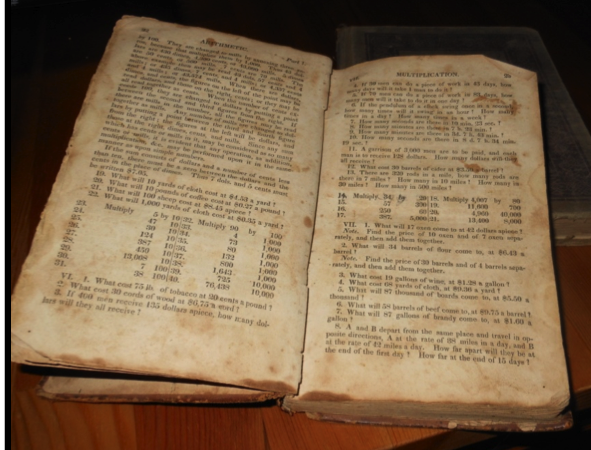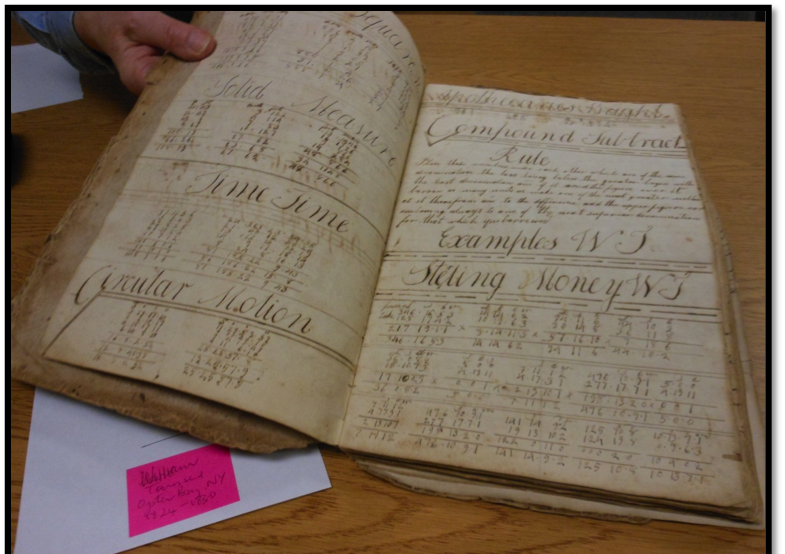- About MAA
- Membership
- MAA Publications
- Periodicals
- Blogs
- MAA Book Series
- MAA Press (an imprint of the AMS)
- MAA Notes
- MAA Reviews
- Mathematical Communication
- Information for Libraries
- Author Resources
- Advertise with MAA
- Meetings
- Competitions
- Programs
- Communities
- MAA Sections
- SIGMAA
- MAA Connect
- Students
- MAA Awards
- Awards Booklets
- Writing Awards
- Teaching Awards
- Service Awards
- Research Awards
- Lecture Awards
- Putnam Competition Individual and Team Winners
- D. E. Shaw Group AMC 8 Awards & Certificates
- Maryam Mirzakhani AMC 10 A Awards & Certificates
- Two Sigma AMC 10 B Awards & Certificates
- Jane Street AMC 12 A Awards & Certificates
- Akamai AMC 12 B Awards & Certificates
- High School Teachers
- News
You are here
An Investigation of Subtraction Algorithms from the 18th and 19th Centuries - Textbooks and Cyphering Books
Introduction
How do you subtract? What is your algorithm of choice? The most common subtraction algorithm in the United States today is the decomposition algorithm. While other algorithms exist and are possibly utilized, no other algorithm dominates the contemporary curriculum, classrooms, and pencils of children in the U.S. more so than the decomposition algorithm. Subtraction is one of the fundamental building blocks of arithmetic. Looking to the past and exploring the history of subtraction algorithms can help us glean knowledge of the intended and possibly implemented curricula in past eras. In this paper, special attention will be given to 18th and 19th century America. The aims of this paper are to identify the different algorithms used during this time period and to discuss implications for the modern teacher.
Textbooks and Cyphering Books

Figure 1. An example of an arithmetic text, First lessons in arithmetic (2nd ed.) by Warren Colburn, published in 1824 in Boston, Massachusetts, by Hilliard & Metcalf. (Photo used courtesy of the book owner, Nicole M. Wessman-Enzinger.)
Utilizing printed books as the solitary source in this investigation would be an insufficient representation of this time period. This is because, as recently shown by Nerida Ellerton and Ken Clements in their book, Rewriting the history of school mathematics in North America 1607-1861 (2012), in North America during the 18th and 19th centuries, printed arithmetic texts were used less often than handwritten cyphering books. Cyphering books, an integral part of the “abbaco” tradition from Europe, were handwritten accounts of some branch of mathematics, usually arithmetic or geometry, prepared by and belonging to specific individuals. In fact, these books were often referred to by those who created them as “my book” or, for example, as “John Smith, his book.” They were typically prepared by students attending school or college or an evening class, both children and adults, and were utilized by their owners throughout their lifetimes. The entries are all in handwritten ink, usually very neat, and some books contain illustrations. The spelling “cyphering” versus the modern “ciphering” is an intentional semantic choice. The word “cyphering” was commonly used before 1800, and the term “copybook” may have been used as well (Ellerton & Clements, 2012).
Cyphering books were copied from a teacher’s or sometimes a parent’s own cyphering books and contain mathematical definitions, rules, and examples (e.g., Brayton, 1792; Butlar, 1785; Green, 1795-1800; Hall, 1780; Moses, 1801; Prust, 1702). As such, these cyphering books represent a valuable look into the implemented curriculum of the era. The printed arithmetic books, representative of the intended curriculum, are what we would now call “textbooks.” In this article, the use of words such as “books” or “arithmetic books” will usually refer to printed arithmetic textbooks. The data for this research came from both of these sources, the printed arithmetic books and the handwritten cyphering books, to represent the implemented and intended curriculum of the time.
For data collection, arithmetic books were selected from those in Nerida Ellerton’s and Ken Clements’ large collection of printed books and were also accessed through Google Books. Approximately 32 arithmetic books were examined from these sources. Ellerton and Clements have established the nation’s largest and most representative collection of cyphering books. All 280 of the cyphering books then in the Ellerton-Clements collection were examined in 2012. The arithmetic and cyphering books from both Google Books and the Ellerton-Clements collection are considered to be a representative sample of the books used in 18th century Colonial America and in the United States during the 18th and 19th centuries.

Figure 2. An example of a cyphering book (W. Townsend, 1824-1830, New York) from the Ellerton-Clements collection. (Photo used with the permission of the book owners, Nerida F. Ellerton and M. A. (Ken) Clements.)
Note on source: The images of pages of cyphering books in this article have been reproduced, with permission, from cyphering books belonging to Nerida F. Ellerton and M. A. (Ken) Clements, who, as of January 2014, own a collection of 350 North American cyphering books, dating from 1701 to 1861. This is the largest collection, public or private, of North American cyphering books. For details relating to these cyphering books, consult Rewriting the History of School Mathematics in North America 1607–1861, by N. F. Ellerton and M. A. Clements (Springer, 2012). Ellerton and Clements have indicated that photographs of excerpts from the cyphering books in their collection can be reproduced in scholarly papers or presentations or in curriculum materials, provided it is indicated that the cyphering books from which the photographs were taken are in the Ellerton-Clements collection and provided reference is made to the above-mentioned book by Ellerton and Clements (2012).
Nicole M. Wessman-Enzinger (Illinois State University), "An Investigation of Subtraction Algorithms from the 18th and 19th Centuries - Textbooks and Cyphering Books," Convergence (January 2014)




